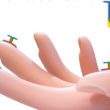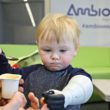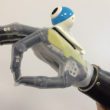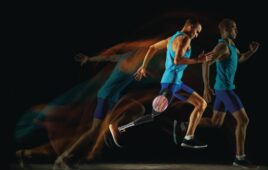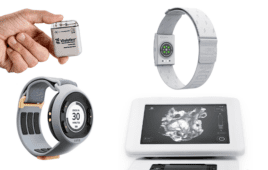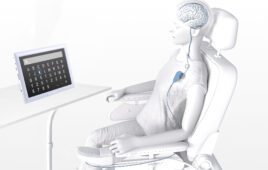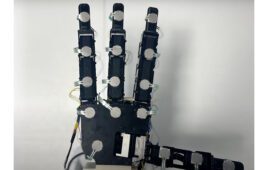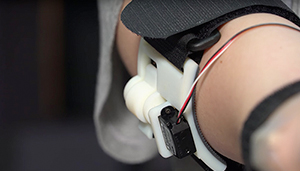
The Rice Haptic Rocker includes a rotating arm brushing a soft rubber pad over the skin of the arm. The more a prosthetic hand closes, the more the pad stretches the skin. {Image courtesy of Brandon Martin/Rice University]
Tactile feedback enabled blindfolded test subjects to more than double their ability to determine the size of objects they grasped with a prosthetic hand, according to U.S. and Italian engineers.
“Humans have an innate sense of how the parts of their bodies are positioned, even if they can’t see them,” said Marcia O’Malley, professor of mechanical engineering at Rice University, in a university news release. “This ‘muscle sense’ is what allows people to type on a keyboard, hold a cup, throw a ball, use a brake pedal and do countless other daily tasks.”
The researchers – from Rice University and the Research Center “E.Piaggio” of the University of Pisa and the Italian Institute of Technology – will present their findings June 7 at the World Haptics 2017 conference in Fürstenfeldbruck, Germany.
O’Malley’s Mechatronics and Haptic Interfaces Lab has sought to develop technology to allow amputees to receive “muscle sense” from their prosthesis. (The scientific term for such muscle sense is proprioception.) Amputees presently need to see their prosthesis in order to properly use it.
“We’ve been limited to testing haptic feedback with simple grippers or virtual environments that replicate what amputees experience,” O’Malley said. “That changed when I was contacted last year by representatives of Antonio Bicchi’s research group at Pisa and IIT who were interested in testing their prosthetic hand with our haptic feedback system.”
Rice graduate student Janelle Clark andPisan graduate student Edoardo Battaglia measured how well blindfolded test subjects were able to distinguish the size of objects grasped with a prosthesis – with and without proprioceptive feedback. Tests involved the Rice Haptic Rocker and the Pisa/IIT SoftHand.
With the 2 devices combined, people in the research study were able to determine a larger object versus a smaller object 70% of the time; it was only 33% when haptic feedback was not used.
The Rice Haptic Rocker’s user interface is simple and noninvasive It uses a rotating arm that brushes a soft rubber pad over the arm’s skin. When a prosthetic hand is fully open, no skin is stretched. Stretching occurs as the hand closes and arm rotates.
“We’re using the tactile sensation on the skin as a replacement for information the brain would normally get from the muscles about hand position,” Clark said. “We’re essentially mapping from feedback from one source onto an aspect of the prosthetic hand. In this case, it’s how much the hand is open or closed.”
The SoftHand also has a simple design. “Experiments show that one synergy explains more than 50 percent of all grasps,” Battaglia said. “SoftHand is designed to mimic this. It’s very simple. There is just one motor and one control wire to open and close all the fingers at once.”
[Want to stay more on top of MDO content? Subscribe to our weekly e-newsletter.]

